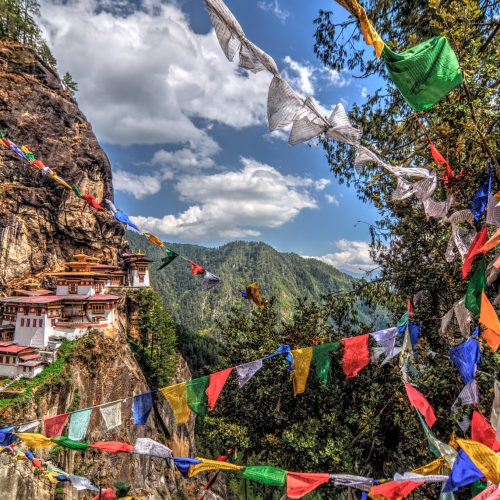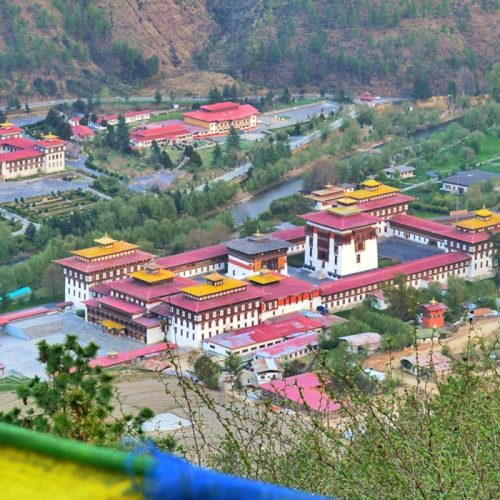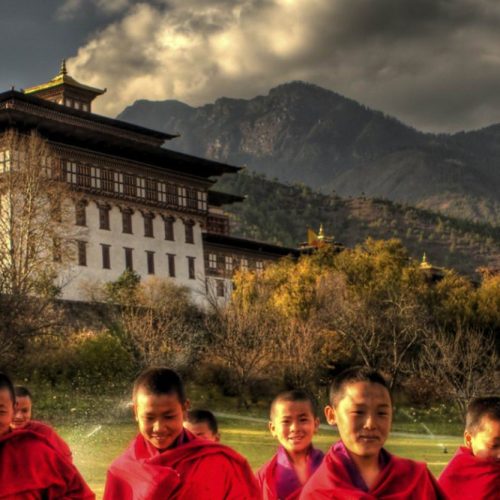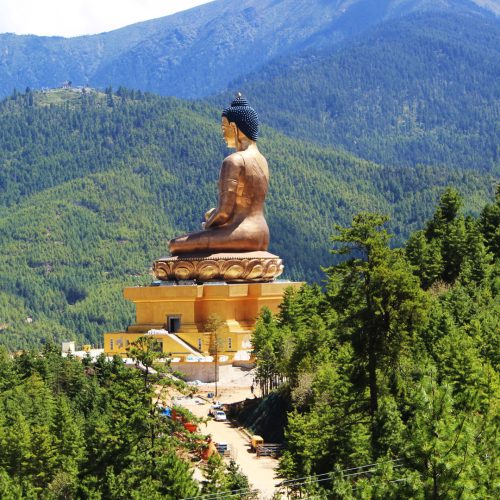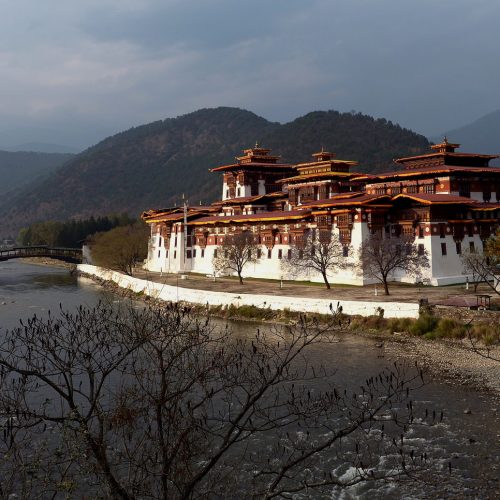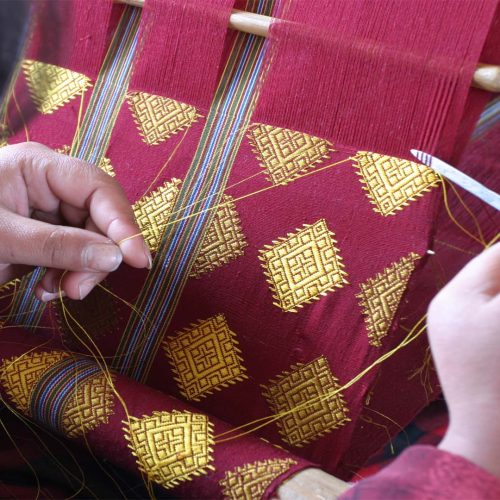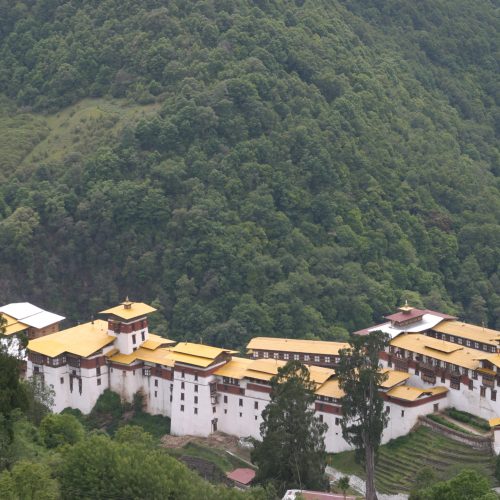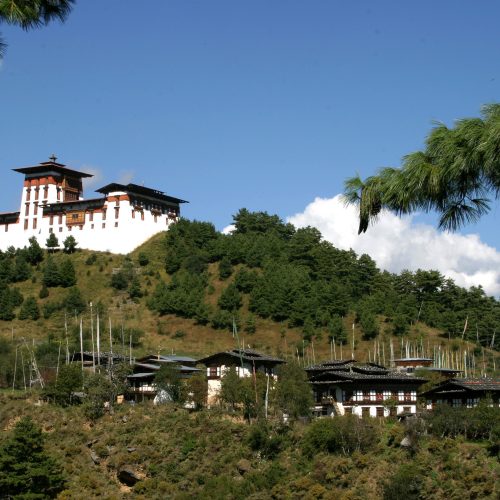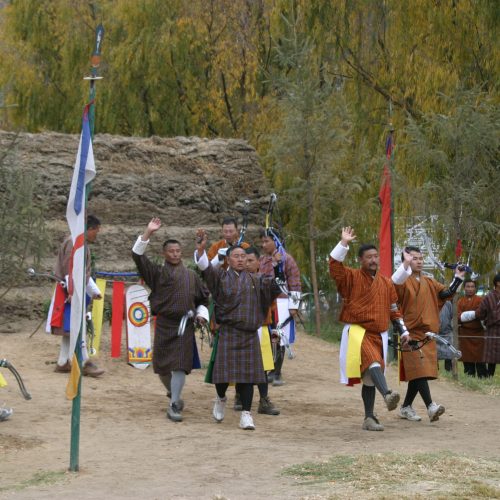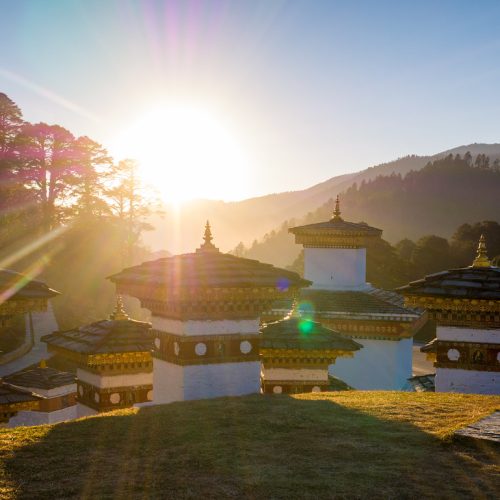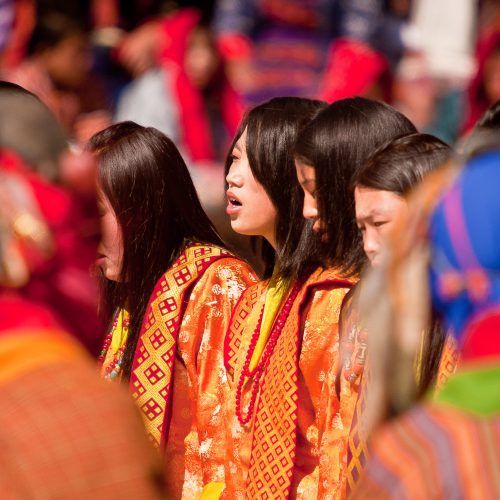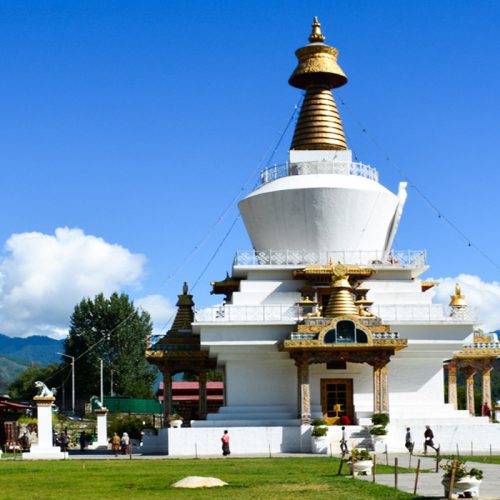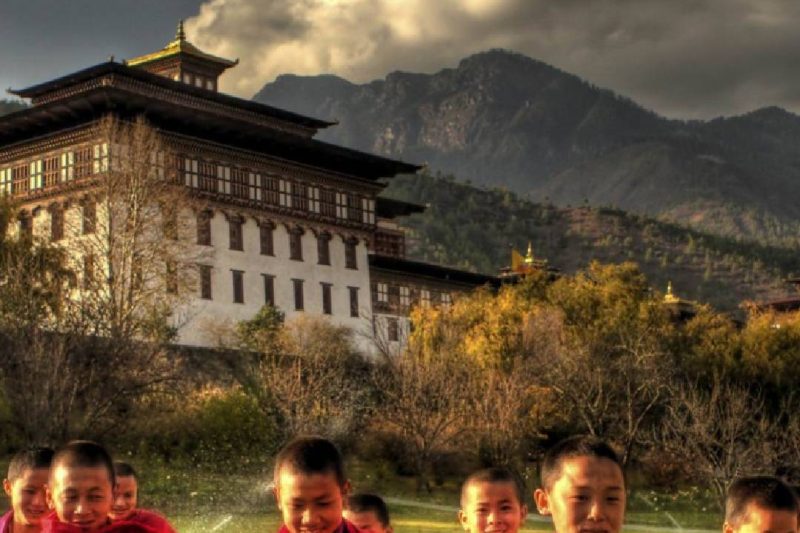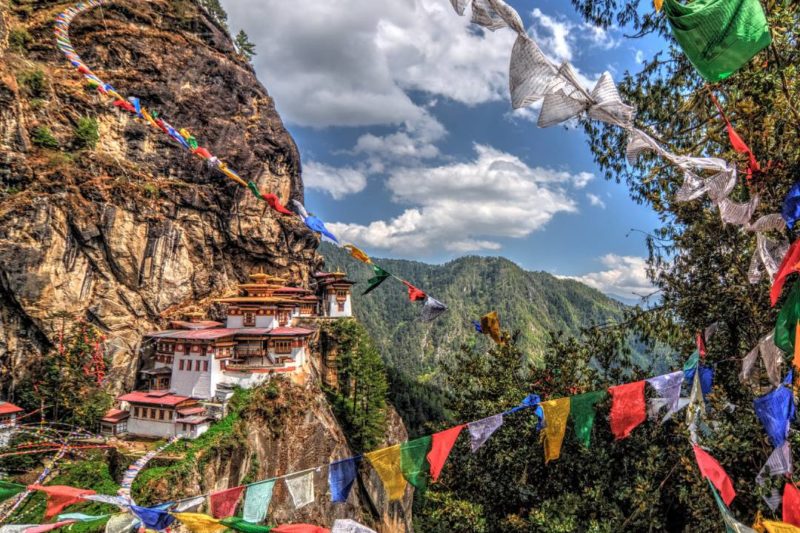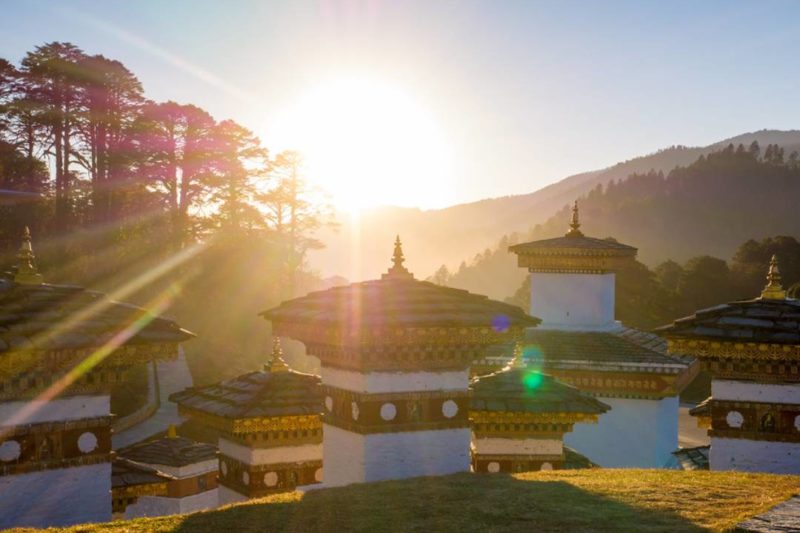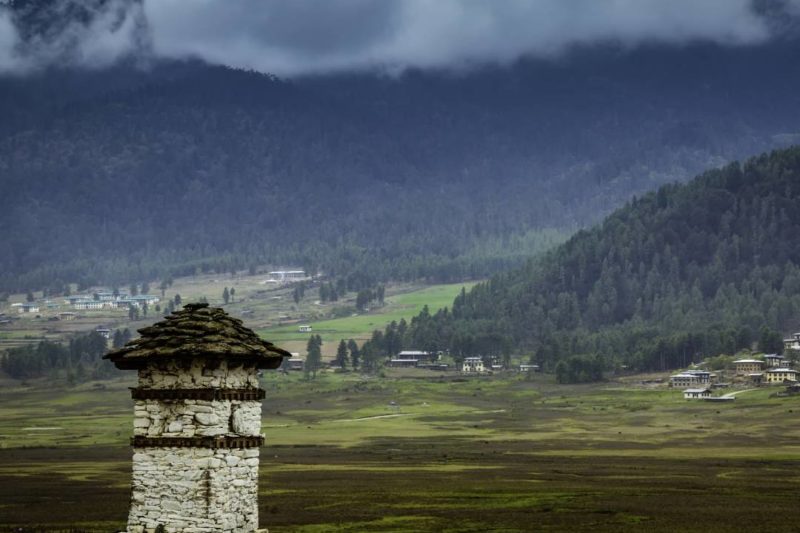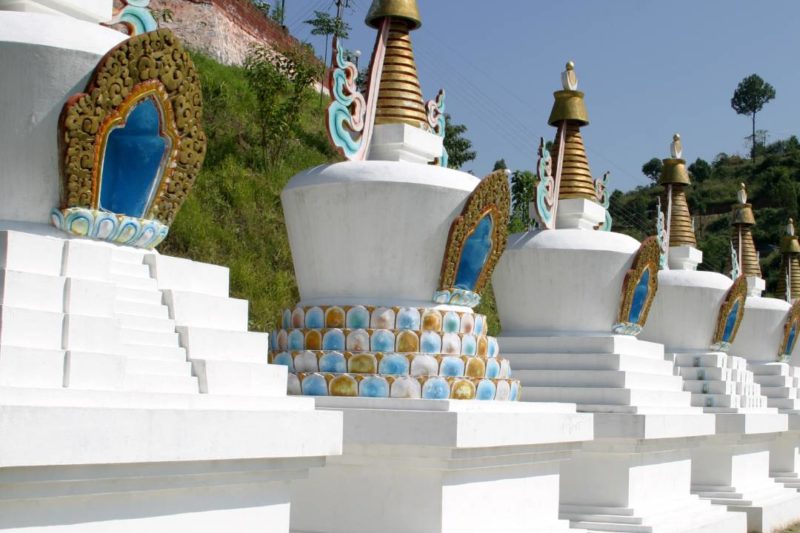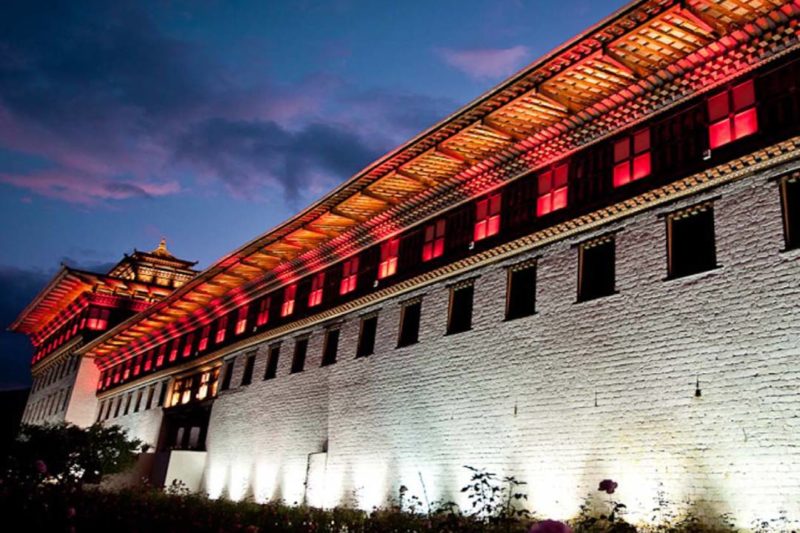This tour takes a journey through the most scenic regions of Bhutan. Discover the valleys of Thimphu, Gangtey, Bumthang, Trongsa, Punakha, and Paro known for their picturesque and green landscape, with lush forests, meandering meadows, spectacular mountains, and historic landmarks. A travel experience through the capital of Bhutan- Thimphu, Punakha – the old capital, and Paro valley. An unforgettable experience and hike to Taktsang- The Tiger’s Nest. The Phobjikha Valley is one of the most beautiful destinations in Bhutan, a Unesco World Heritage Site. Explore the vibrant atmosphere and daily hustle and bustle of Thimphu and Paro town while also experiencing spectacular views of the Himalayan range, its snowy peaks and the lush green forests Bhutan has to offer.
Altitude in Paro: 2,280m
Altitude in Thimphu: 2,320m
Distance: 55km
Estimated travel time: 1.30hr
Onboard the aircraft, the flight is treated to spectacular views of snow peaked mountains and the Himalayan ranges. Paro airport (2,280m) is Bhutan’s only international airport where our dedicated team will then take you to the capital city Thimphu, an estimated one-and-a-half-hour drive of 55km.
Tachogang Lhakhang –This ancient temple was built by Thangtong Gyalpo, the Bhutanese legendary iron bridge builder. The story goes that Thangtong Gyalpo was inspired by the vision of the spiritual horse Balaha (an emanation of Chenrizig Avalokiteshvara) when he was meditating at the very same spot of the temple.
National Memorial Chorten – one of Bhutan’s most prominent buildings. The Chorten is the monument of world peace and prosperity. For Bhutanese, the site also serves as the memorial to their Third King, His Majesty Jigme Dorji Wangchuck (1928-72).
Buddha Point (Buddha Dordenma) - At a height of 51,5m, placed on top of a hill in Kuenselphodrang Nature Park, the sight of the enormous statue of Shakyamuni Buddha is stunning and unforgettable. This giant statue is one of the largest in the world and is said to emanate an aura of peace and happiness.
Tashicho Dzong (Fortress of The Glorious Religion)- Tashichho Dzong has been the seat of the Bhutan government since 1952. Through the years, the dzong has gone through expansions and renovation and presently houses the throne room and offices of the king, the secretariat and the ministries of home affairs and finance. Other government departments are housed in buildings nearby.
Exploring the nooks and crannies of Thimphu city. Walk the streets of the capital, live the commotion, and experience the nightlife with good food and music.
Altitude in Gangtey: 2,900m
Distance: 160km
Estimated travel time: 6hrs
Dochula Pass (3,050m)- Panoramic view of the Himalayan mountains. The pass is a popular location among tourists as it offers a stunning 360 degree panoramic view of the Himalayan mountain range. The view is especially scenic on clear, winter days with snowcapped mountains forming a majestic backdrop to the tranquility of the 108 chortens gracing the mountain pass.
Gangtey Goemba or ‘Gangtey monastery’- The only Nyingmapa monastery in this region, sitting on the crest of a hill on top of Gangtey valley. The monastery was built in 1613 following the prophecy of Pema Lingpa – the famous 15th-century treasure finder.
Altitude in Bumthang: 2,800m
Distance: 158km
Estimated travel time: 6hrs
Gangtey Nature Trail – A scenic trail of the Phobjikha Valley, a Unesco World Heritage Site.
A popular trail leading to a small hilltop overlooking Gangtey Goemba to lovely flower meadows and into Semchubara village. The trail continues through pristine forests of blue pine to the valley viewpoint where the trail ends at the Khewang temple.
Black-necked Crane Visitor Centre- The center focuses on sustainable ecotourism activities, environmental education, and conservation programs in Phobjikha valley. The building’s location allows people to overlook the wetlands, which is the Black-necked crane’s habitat.
Cycling or hiking in the valley as well as watching the cranes during the winter months.
Bumthang – the Spiritual Heartland of Bhutan. The region is home to some of the oldest palaces, Buddhist temples, and monasteries of the kingdom.
Yathra Weaving Center- A well-known weaving center in Chumey valley, Bumthang. Witness and experience Yathra weaving, the regions special woven textile with intricate patterns that has been passed down for generations here in Chumey.
An option to fly domestically from Paro to Bumthang with return or return on road can also be tailored to your requests (please contact us for this request).
Altitude in Bumthang: 2,800m
Jambay Lhakhang- Belonging to the 108 temples built by the Tibetan King Songsten Gampo in the 7th century. It is believed that a supine demoness was causing obstruction to the spread of Buddhism, and the temples were constructed on her body parts that spread across Tibet, Bhutan and the borderlands.
Kurjey Lhakhang- The large, active and important temple complex is named after the body (kur) print (jey) of Guru Rinpoche, which is preserved in a cave inside the oldest of the three buildings that make up the complex.The first temple, also the most sacred one, was erected in 1652 and is where the body print of Guru Rinpoche is protected. The second one was constructed by Ugyen Wangchuck, the first king of Bhutan, and the third temple was established by Ashi Kesang Wangchuck, queen to the third king, in 1984.
Kurjey Drupchu- located next to the Kurjey temple, the holy water believed to be blessed by Guru Rinpoche can be found.
Tamshing monastery (Temple of the Good Message)- Established in 1501 by Pema Lingpa, it is the most important Nyingma Goemba in Bhutan. An option to walk from Kurjey Lhakang is also possible taking around one hour.
Lhodrak Kharchu Monastery- The renowned monastery was blessed by Guru Rinpoche and is the seat of the successive Namkhai Nyingpo reincarnates.
Walk to Bumthang town
Altitude in Bumthang: 2,800m
Mebar Tsho – the Flaming Lake- One of the holiest sites in the region. Located at the lower end of Tang valley, the sacred lake is related to the renowned religious treasurer Terton Pema Lingpa. According to legend Terton Pema Lingpa had a vision of the sacred treasures that Guru Rimpoche had hidden within the lake centuries earlier. However, the people of Tang and the local ruler were cynical of his claims. To prove his claims, Pema Lingpa held a butter lamp in his hand as he jumped into the lake. After remaining under water for a long time he re-emerged holding a chest and a scroll of paper with the butter lamp held in his hand still burning bright. Thereafter, the lake came to be known as Mebartsho (the burning Lake).
Hike to Tang Ogyen Choling Palace and Museum- This Bhutanese site is one of eight sacred locales established by a revered 14th-century Buddhist master. The building, which has since been converted into a museum to promote its conservation and to drive tourism to the village, was largely destroyed following an earthquake in the late 1800s. The residential quarters, the main temple, and the tower were all rebuilt, and the site continues to beckon visitors and religious pilgrims alike.
Altitude in Trongsa: 2,216m
Distance: 80km
Estimated travel time: 3hrs
Trongsa Dzong – The stunning dzong at Trongsa commands an impressive position above the Mangde River and is visible for many miles around. Within the walls a maze of courtyards and corridors reveal temples and towers adorned with colorful mandalas and Buddhist statues. The great watchtower, overlooking the town, offers breathtaking views of the dramatic valley landscape. The Dzong served as the seat of the Wangchuck dynasty before the enthronement of the first king in Bhutan.
Ta Dzong – The Ta Dzong is a majestic circular five story tower flanked by two lower towers. With its magnificent design and impressive aesthetic, the Ta Dzong is an awe-striking marvel of traditional Buddhist architecture and a popular tourist attraction. Converted into the National Museum of Bhutan, one of the most fascinating museums travelers can find in the country.
Kuenga Rabten- Next destination 23km drive from the south of Trongsa taking an hour’s drive. Along the journey, Takse village will be one of the stops adorned with a giant waterfall and fertile rice terraces. The Second King’s winter palace is also situated here and will provide an insight into the early days of Bhutan’s monarchy.
Karma Drubdey Nunnery- First opened in 1968, now serves as a monastic school (shedra), retreat center (drupde), and monastic institution (dratshang).
Altitude in Punakha: 1,300m
Distance: 150km
Estimated travel time: 5hrs
Punakha Dzong (Palace of Great Happiness)- Built-in 1637, it is said to be the most spectacular dzong in Bhutan. Punakha Dzong was built at the confluence of two major rivers in Bhutan, the Pho Chhu and Mo Chhu, which converge in this valley.
In addition to its structural beauty, until the mid-1950s, it still served as Bhutan’s capital and the seat of the government. All of Bhutan’s kings have been crowned here, and it has witnessed the memorable wedding of the King of Bhutan, Jigme Khesar Namgyel Wangchuck to Jetsun Pema in 2011.
Pho Chhu Suspension Bridge- Measuring at 160m in length, this is Bhutan’s longest suspension bridge. Spectacular sight of Punakha Dzong and Pho Chhu Valley.
Khamsum Yulley Namgyal Chorten (1,500m)- A leisure 1 hour hike to witness Bhutan’s finest example of tradition and architecture. A unique attribute of this Chorten setting it apart from the rest is in its architecture- designed on the principals delineate within the Holy Scriptures instead of trendy engineering manuals. The golden spire and labyrinthine wall patterns square measure fine example of art and traditions
Altitude in Paro: 2,280m
Distance: 125km
Estimated travel time: 4hrs
Chimi Lhakhang- Hike to the Temple of Fertility (altitude: 1,500m). An enjoyable hike, taking about 30 minutes through the rice and mustard fields and the uniquely decorated houses of Lobasa Village.
Paro Rinpung Dzong (Fortress of The Heap of Jewels)- Rinpung Dzong is an ancient fortress in traditional Bhutanese architecture with a complex of courtyards, temples, administration offices and open space surrounded by towering walls. All the buildings are equipped with huge windows with elaborate wooden carvings of traditional Bhutanese motifs. Paro Dzong is considered one of the finest examples of Bhutanese architecture and it’s one of the top tourist attractions in Bhutan. This impressive dzong is also seen during landing into Paro Airport.
National Museum of Bhutan – Ta Dzong. Originally built as a watchtower in 1649, atop a hill above the Rinpung Dzong, overlooking the whole picturesque Paro valley. Converted into a museum in 1968, its extensive collection includes astonishing antique thangka paintings, weapons and armor, and rich diversity of natural and historic artifacts.
Shagzo (Bhutanese woodturning at Sangay Wood Turning Factory) - The shagzo techniques use the age-old methods and each product is unique in shapes, sizes and colours. Learn the Shagzopa (Shagzo artisans), the essential steps in creating the elegant and functional products like wooden bowls (dapa), cups (dza phob) and plates with beautiful patterns, while keeping the ‘soul’ of the wood in it.
A stroll through Paro town.
Altitude in Paro: 2,280m
Taktsang Monastery, or the Tiger’s Nest (highest altitude: 3,120m)- A 4.5 km hike that will typically take 5-6 hours ascending around 600m to reach the destination. An experience through dense enchanted forests and spectacular mountain scenery along the trail.
Kyichu Lhakhang- one of the 108 temples built throughout the Himalayas by the Tibetan King Songtsen Gampo in the 7th century. The main chapel has roots as far back as the 7th century, with additional buildings and a golden roof added in 1839 by the penlop (governor) of Paro and the 25th Je Khenpo. Elderly pilgrims constantly shuffle around the temple spinning its many prayer wheels, making this one of the most charming spots in the Paro valley.
Traditional meal at a farmhouse learning about Bhutanese daily life. A traditional hot stone bath at the farmhouse after all the hiking is also an option provided for relaxation.


